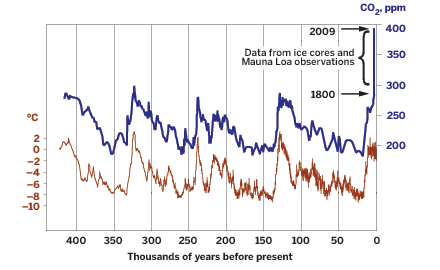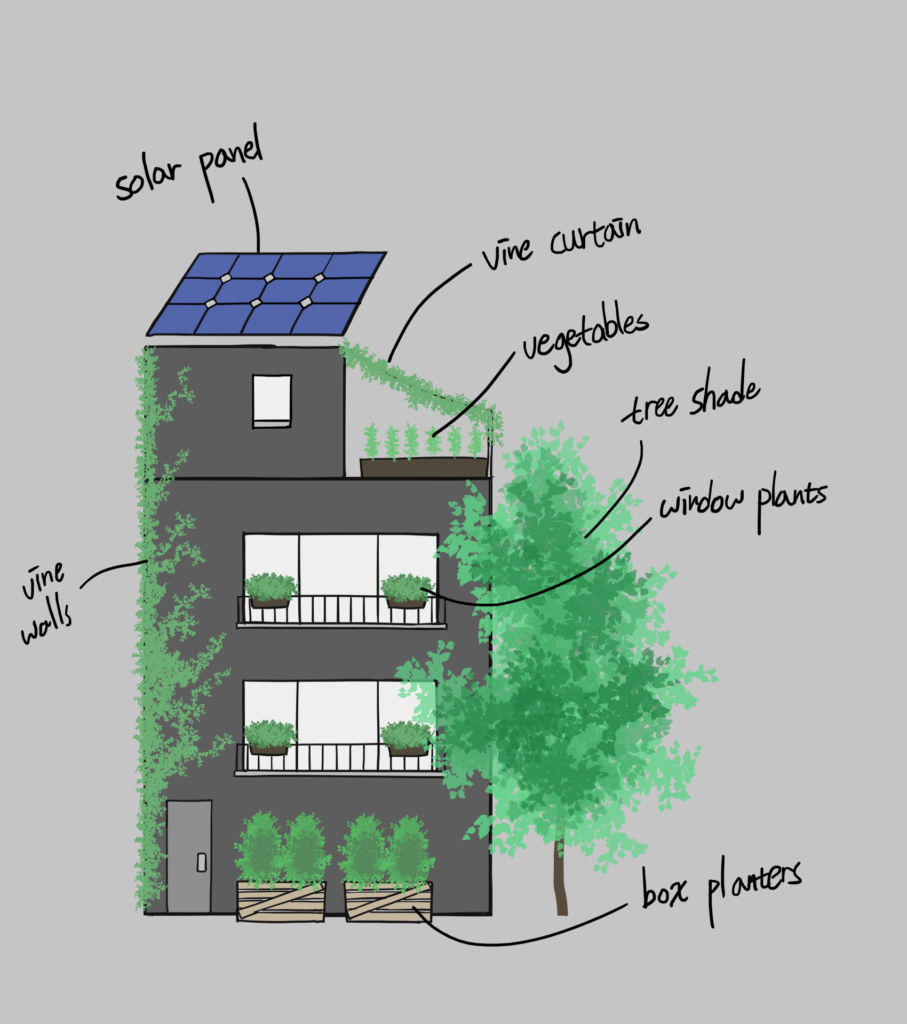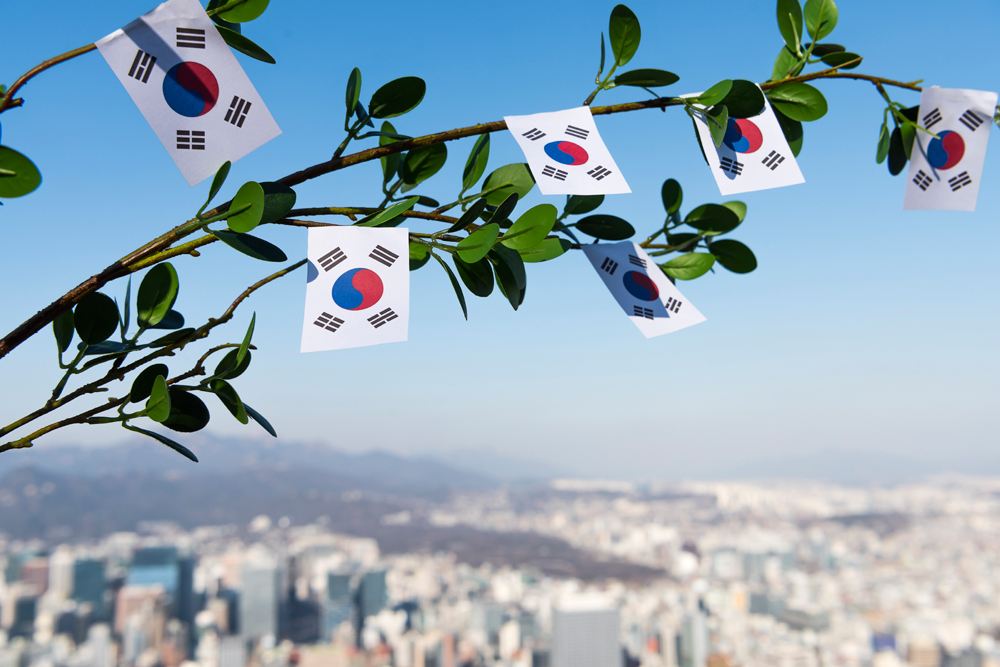More Trees, Please! CO2 and the Temperature
By Chung Hyun-hwa
In times of climate crises, the removal of carbon is of great interest to a lot of scientists in the environmental technology field. Recently, I thought, “What if we built machines to remove carbon directly from the air?” Then, of course, I found that there are already such machines being developed. (You always get surprised once you realize you are not the only one thinking about certain things.) Scientists say the amount of carbon dioxide in the air was never higher than 300 ppm until the Industrial Revolution. Now it is about 400 ppm on average.
In the history of Earth, the data show a direct proportional relation between carbon dioxide and temperature. Presently, the carbon dioxide level is much higher than at any other time in the past 800,000 years. Therefore, given trends in carbon dioxide production, the temperature is set to go up, logically speaking. Scientists have warned that without any intervention, by the year 2100, the temperature will go up by at least 5 degrees Celsius. There has been an agreement that a 1.5-degree rise (compared to before the Industrial Revolution) will be the tipping point that will lead us to an irreversible state. This year, we have reached 1.1 already. I am still hopeful there will be innovative technologies to help us control global warming before it is too late.

Carbon dioxide in the air. (Michael Ernst, Woods Hole Research Center
The Most Proven Carbon-Offset Method
To fight against the climate crisis we face, scientists in all different sectors are trying to find ways to help with carbon removal, including through direct carbon capture from the air, utilizing renewable energy sources, driving more hydrogen-powered electric vehicles, and cutting carbon in conventional economic sectors, to name a few. Although such things are being developed in haste, achieving each at a commercially viable level takes time, and even though I am looking on the bright side, waiting for the advent of new technologies seems daunting. Therefore, I have thought of ways to remove carbon dioxide that we could start right now and concluded that planting trees is the best.
Planting trees is not high tech at all, so I have liked it from the outset. It can be done anytime and anywhere at comparatively low costs. It is also something we already know a lot about. To maximize storing carbon in trees, they should be alive. As soon as they are dead, or are cut down to be used, they start to release carbon and do so especially quickly when they are burnt. Living trees keep collecting carbon without any power supply needed. All they need are water and sunshine.
Korea’s Tree-Planting Plan
Korea declared this year that three billion trees would be planted by 2050 to offset carbon emissions, and three hundred million inefficient, old trees would be cut down selectively. The cut-down trees could be used as wood material or biomass fuel. This is supposed to have a 34-million-ton offset effect. Regarding the lumbering aspect, the Korea Forest Service says trees that are over 30 years old are not so efficient in capturing carbon, and that most of the trees in Korea were planted after the war, making many of them unsuitable to meet wood demands for buildings and furniture. However, environmental activists do not agree because there is evidence that old trees are still effective in removing and storing carbon due to their volume and the amount of carbon in the soil. They say that because it takes time to grow young trees, cutting down older trees may be too big a risk to take in the face of the urgent current climate crisis. These two perspectives are so controversial that there should be more thorough research done before taking any action because planting a forest is a huge project that takes over 20 years, at least. Forty percent of Korea’s forests are for lumber production, and it is true that we have a need for wood in our lives as an environment-friendly architectural resource, so cutting down inefficient trees may be a matter of timing and speed or amount. Tree policies are important because trees play a crucial role in carbon-related issues whether they are alive or cut.

Gwangju’s Tree-Planting Plan
To take part in Korea’s big planting project, Gwangju City announced in 2018 that 30 million trees would be planted in the city by 2027. Gwangju City emphasized the need for more trees in the city, citing research by the National Institute of Forest Science that found that one tree can release 150–300 ml of water into the air to draw down the temperature, and that the temperature of an urban forest is 3–7 degrees lower than its surroundings, creating much-needed air flow in the city that helps cool down urban surroundings. Gwangju plans to remove unnecessary walls that block this air flow and replace them with trees, to plant more trees along the streets, existing parks, and schools, and to place more planters throughout the city where land is not available. This year, there have been four places chosen for these wind-providing forests: Nokdong Station, Hyocheon-ro, Wangbeodel-ro, and Mujindae-ro. This part of the project is to be completed in 2022. Hopefully in a few years, we could find more green, shady areas in the city and feel the difference in the temperature and air quality.

What We Can Do
While the city follows the above plan, we can plant something inside and outside our homes or on the rooftop. The roof should be checked for any leakage in advance, but once set, getting your leeks, peppers, and perilla leaves from your own rooftop or balcony is pretty cool. Rooftop plants also cool down the temperature of the building. I started putting plant boxes on the rooftop this year, but I admit it was not so easy in the beginning because the rooftop is very hot in the summer. You will have to choose the kind of plants that like hot temperatures. I found that green onions, peppers, and tomatoes are quite suitable for the rooftop (especially green onions, which can grow in shallow soil straight from store-bought green onions with roots). Some people grow their own lettuce in DIY PET bottles or even horizontal or plastic bags on the balcony. Any produce grown this way is very organic and fulfilling.
I am also thinking of planting some fast-growing vines for a green curtain next year to provide shade for the house. Maybe a cucumber plant would be nice, although ivies need lower maintenance. If more buildings do this, it will help bring temperatures down across the city. Having some fresh cucumbers on the table would be a bonus, too. Right next to my house, there is a tall, fast-growing paulownia empress tree that is as high as my house this year, and thanks to it, I learned the power of tree shade over a room’s temperature. The increase in the temperature nowadays is becoming a hazard to financially vulnerable people who cannot afford a good cooling system. That is one more reason we should try to control the temperature in the city. Planting trees, in this sense, is a meaningful weapon. Power cables over the streets are obstacles, so we should try and find places that do not have them. I think we should pay attention to the Gwangju Stream and the Yeongsan River, which flow through and around the city – these areas have few power cables and a lot of room. If we created a thick forest along the stream and the river, this would become the lungs of the city to provide oxygen, and offset carbon and fine dust. Imagine people walking, running, or riding bikes in the shade of the trees while breathing in phytochemicals and oxygen from them.
When Is the Best Time to Plant?
Wise people say it was 20 years ago, and that the second best time is now. Korea’s Arbor Day is April 4, but now botanists say it should be moved to March because of global warming. Spring is a good time, but between late October and early November is a good time, too. Plants stop activities in the fall and get ready for winter by storing water in their roots rather than distributing it to upper portions. If you plant a tree in the fall, you will not have to give it water as often as if you plant in the spring. About a month’s time and some insulation before the temperature drops to below zero will prepare the trees for winter, and they will start sprouting right away when the spring comes. Trees planted in the spring need to settle before producing new leaf buds. So, how about we all plant one tree this fall? Trees are givers. They give you everything they have for their entire lives. They are also takers. They take heat and carbon, and maybe your heart, too. We need more tree allies. Join the parade.
Resources
(재)국제기후환경센터. (2019, January 19). “적용가능한 온실가스 감축정책 연구보고서.” http://www.icecgj.or.kr/Board/kr/0203/View/adfb3a7894da8432049cced463eb5f3c/Page/3
박수진. (2021, April 29). “고층 아파트로 막힌 광주 도심 숨통 틔운다.” https://www.jnilbo.com/view/media/view?code=2021042916092718424
산림청. (2021, January 21). “2050년까지 30억 그루의 나무심어 탄소 3,400만톤 줄인다.” https://blog.daum.net/kfs4079/17215458
환경운동연합. (2021, July 21). “숲은 나무만 탄소를 저장하는 게 아니다.” https://blog.naver.com/kfemblog/222439259848
한국목재신문. (2021, June 15). “경제림 조성 시급한데 난데없는 벌채 논란.” https://post.naver.com/viewer/postView.naver?volumeNo=31749697&memberNo=37553359
The Author
Chung Hyun-hwa is from Gwangju and is currently leading Gwangju Hikers, an international eco-hike group at the GIC, while getting ready to teach the Korean language. Previously, she taught English in different settings, including Yantai American School and Yantai Korean School in China, and she has worked for the Jeju school administration at Branksome Hall Asia in recent years. She holds a master’s degree in TESOL from TCNJ in the U.S.







